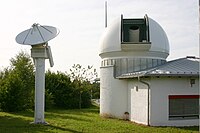
Photo from wikipedia
High-precision and high-resolution satellite altimetry data from CryoSat-2 are widely utilized for marine gravity inversion. The vertical gravity gradient is a crucial parameter of the Earth's gravity field. To evaluate… Click to show full abstract
High-precision and high-resolution satellite altimetry data from CryoSat-2 are widely utilized for marine gravity inversion. The vertical gravity gradient is a crucial parameter of the Earth's gravity field. To evaluate the performance of vertical gravity gradient determined from CryoSat-2 altimeter data, the pre-processed along-track sea surface heights (SSHs) are obtained through error correction. The study area focused on the Arabian Sea and its surrounding region, where the along-track geoid was derived by subtracting the mean dynamic topography of the ocean from the along-track SSH of CryoSat-2. The residual along-track geoidal gradients were obtained by adjusting the along-track geoid gradients calculated from CryoSat-2 altimeter data using the remove-restore method. This was done by subtracting the geoid gradients calculated by the gravity field model XGM2019e_2159. After obtaining the residual along-track geoidal gradients, the residual gridded deflections of the vertical (DOV) are calculated using the least-squares collocation (LSC) method. The residual gridded DOV are then used to compute the residual gridded gravity anomaly gradients in the study area using the finite difference method. After restoring the gravity anomaly gradients computed by the XGM2019e_2159 model, a high-resolution gravity anomaly gradient model with a resolution of 1′×1′ is obtained for the Arabian Sea and its surrounding area. To evaluate the accuracy of the gravity anomaly gradient model derived from CryoSat-2, it was compared with the SIO V32.1 gravity anomaly gradient model released by the Scripps Institution of Oceanography. The comparison showed that the root mean square (RMS) of the differences between the two models is 7.69E, demonstrating the high accuracy and precision of the vertical gravity gradient determined from CryoSat-2 altimeter data.
Journal Title: Geophysical Journal International
Year Published: 2023
Link to full text (if available)
Share on Social Media: Sign Up to like & get
recommendations!